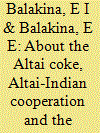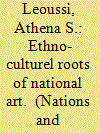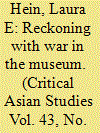| Srl | Item |
| 1 |
ID:
138525


|
|
|
| 2 |
ID:
050927


|
|
|
|
|
| Publication |
Jan-Apr 2004.
|
|
|
|
|
|
|
|
|
|
|
|
|
|
|
|
| 3 |
ID:
103856


|
|
|
|
|
| Publication |
2011.
|
| Summary/Abstract |
How do people handle their regret at having believed that a foolish war was not just acceptable but necessary? Japan after World War II provides an instructive example. Many contrite Japanese revisited the aesthetic realm, looking for ways to interpret culture that did not convey the values of fascism, such as glorifying willing surrender to a powerful leader. They saw their task as engendering an individual aesthetic and therefore political subjectivity, so that Japanese would in the future more bravely resist state violence at home and abroad. These individuals saw culture as intrinsically political rather than as a refuge from politics. Recognizing the difficulty in countering fascist culture through ideas alone, they also created what economists today call "capacity building" institutions to help them do so, such as Japan's first museum dedicated solely to modern art, the Kamakura Museum of Modern Art, established in 1951. The founders of the Kamakura Museum self-consciously set out to create a new institution that would embody a democratic aesthetic and so prevent-they hoped-Japan from repeating the disastrous experience of war. The curators argued for diverse and dynamic modernities, a concept that parried both the idea that artistically Japan was a pale copy of modern Europe and the notion of a single national culture in Japan or elsewhere. At the same time, however, the legacy of the war was visible in an entirely different and less admirable way in the museum curators' stance toward Asian modernity beyond Japan and its evasion of Japan's responsibility for the wartime devastation of China.
|
|
|
|
|
|
|
|
|
|
|
|
|
|
|
|